WAVE Wireless Charging Propels AVTA to Zero-Emission Milestone
HOW WIRELESS CHARGING HELPED THE ANTELOPE VALLEY TRANSIT AUTHORITY BECOME THE FIRST ALL-ELECTRIC ZERO-EMISSION TRANSIT FLEET IN NORTH AMERICA
OVERVIEW
“How can we make our electric buses go as far as diesel buses?” It’s a question that every transit agency will face in their zero-emission journey. Yet, at the Antelope Valley Transit Authority (AVTA), battery-electric buses have no trouble matching the range of diesel.
Since 2018, AVTA has been home to the largest deployment of high-power wireless vehicle charging systems in the world. And in March of 2022, AVTA became the first all-electric zero-emission transit fleet in North America.
This is no coincidence.
”WAVE has played a huge role in AVTA becoming the first all-electric zero-emission fleet. Having those chargers out there has enabled us to double vehicle range and run a lot longer.
MARTIN TOMPKINSEXECUTIVE DIRECTOR/CEO | AVTA
This case study outlines how fast, hands-free wireless (inductive) charging from WAVE enabled AVTA to meet California’s zero-emission transit mandate 18 years ahead of schedule.
KEY FINDINGS
Wireless Charging:
BY THE NUMBERS
The Antelope Valley Transit Authority operates the largest battery-electric bus fleet in the U.S. The majority of their vehicles are powered by WAVE Charging via the largest high-power wireless charging system in North America.
WIRELESS-ENABLED FLEET
200
Total Fixed-Route Service Miles
12
at 250kW with 3 more in 2022
47
BYD wireless-equipped BEBs
(28 more in 2022/23)
RANGE EXTENSION
286
Covered longest route of 286 miles (vs. operating range of
155 miles*)
2
Doubled standard operating range in an 8-hour shift*
16
Added over 400 miles during 16 hours operation
* standard operating range of a BYD K9
BENEFITS OF USING WAVE WIRELESS CHARGING**
(JAN. 2019 – JUN. 2022)
miles
Total range extension miles delivered
MWh
Power delivered
gallons
Diesel fuel saved
lbs
CO2 saved
lbs
PM2.5 saved
** benefits attributed solely to WAVE wireless charging
From Idea to Success: The AVTA EV Charging Journey
AVTA serves Antelope Valley in northern Los Angeles County, which extends south into the Los Angeles basin and north to Edwards Air Force Base and the Mojave Air and Space Port. With a total annual ridership of more than two million commuters, the fixed-route service consists of 13 local transit routes covering 200 square miles and 9,600 miles of daily service. The climate is extreme, with year-round temperatures ranging from 15°F to 110°F.
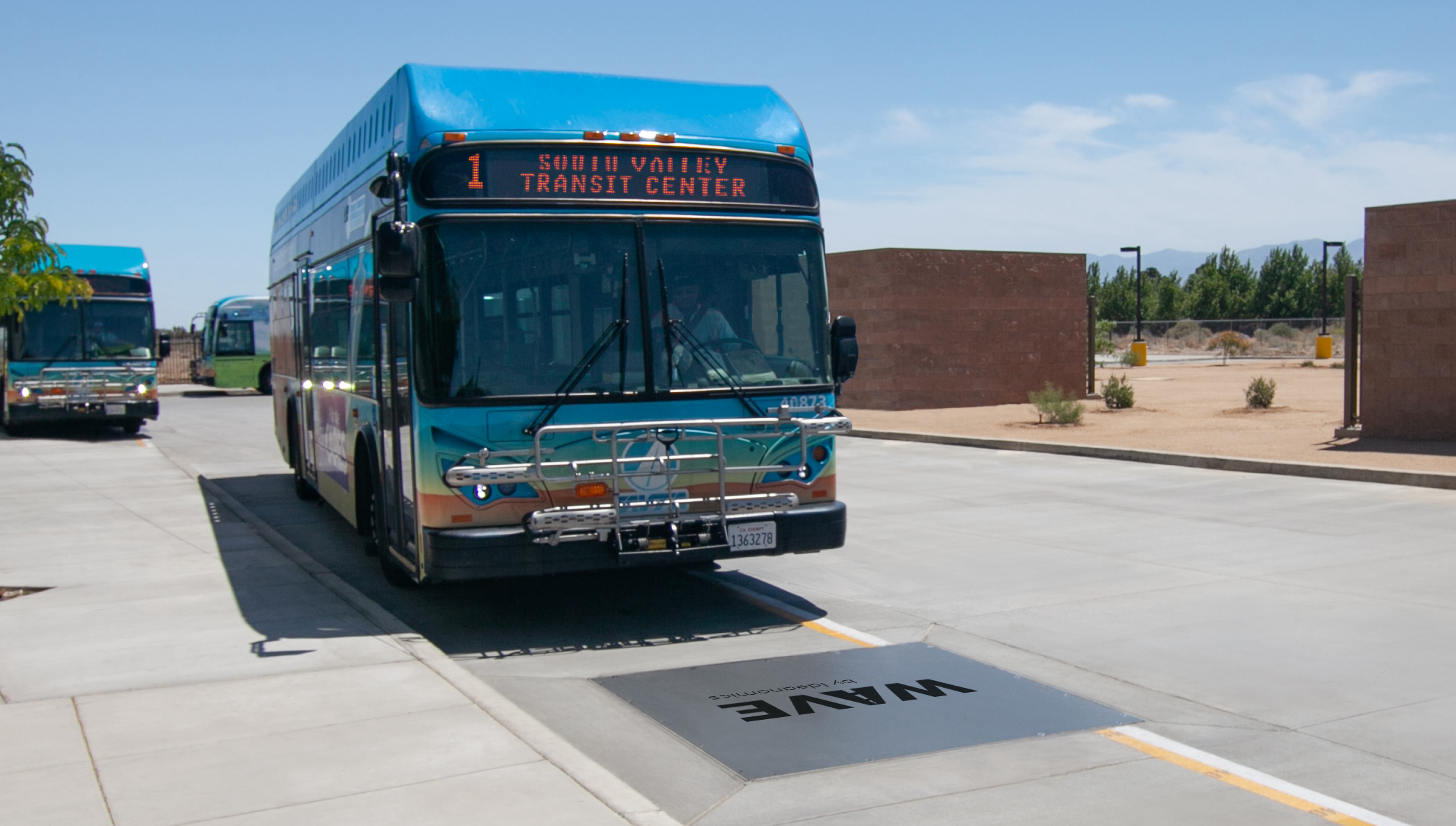
In 2012, AVTA’s leadership set out to become the first transit operator in the United States to have a fully electric local bus fleet. The standard stated range of a battery-electric bus then was approximately 155 miles. The agency needed to solve the problem of covering 15 local transit routes that averaged 290 miles in length.
Today, AVTA has deployed 12 WAVE 250 kilowatt (kW) wireless chargers over 200 square miles. Of the 65 BYD battery-electric buses AVTA is operating, 47 are equipped for wireless charging. In the Fall of 2021, AVTA placed an order to wirelessly equip the remainder of their fleet.
As of June 2022, AVTA is operating the largest battery-electric bus fleet in the country and logged its eight millionth zero-emission mile—a record for U.S. transit agencies.
How Wireless Charging Works
Inductive charging requires no physical connection. As a bus operator approaches a wirelessly equipped transit stop, they align the steering column with a stripe painted on the pavement. A second set of markings visible through the doors indicates where to stop. An onboard display confirms alignment. Charging begins only after the operator places the bus in neutral, applies the parking brake, and kneels the bus. Current sent through the pavement-embedded charging pad induces a magnetic field, which induces an electrical current in a receiver plate mounted on the bottom of the bus. That power is then sent to the onboard battery.
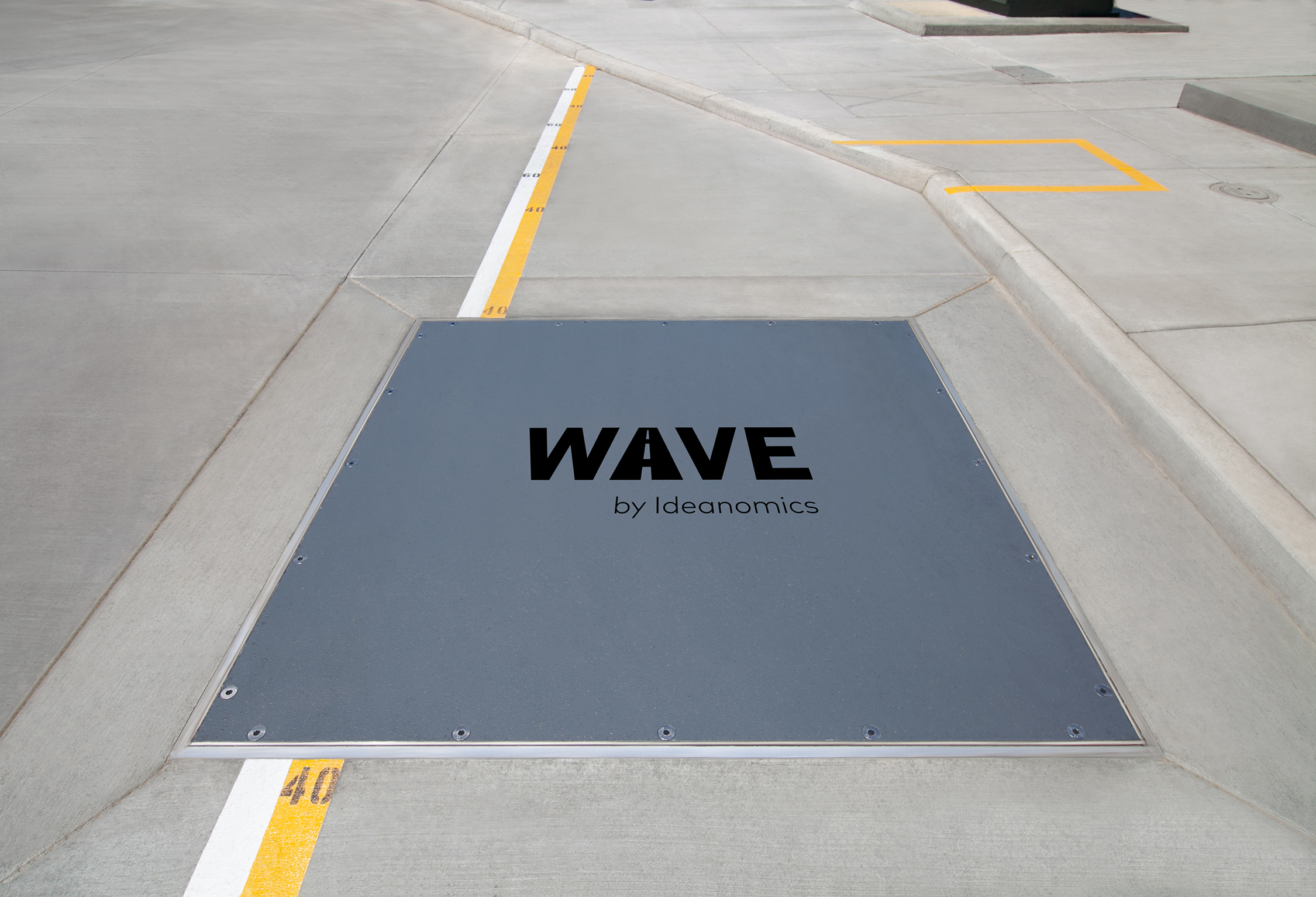
The system is unaffected by snow, ice, moisture, and heat and is nearly as invisible as it is indestructible. Free of moving parts, connectors, or cables means there is nothing to break or freeze.
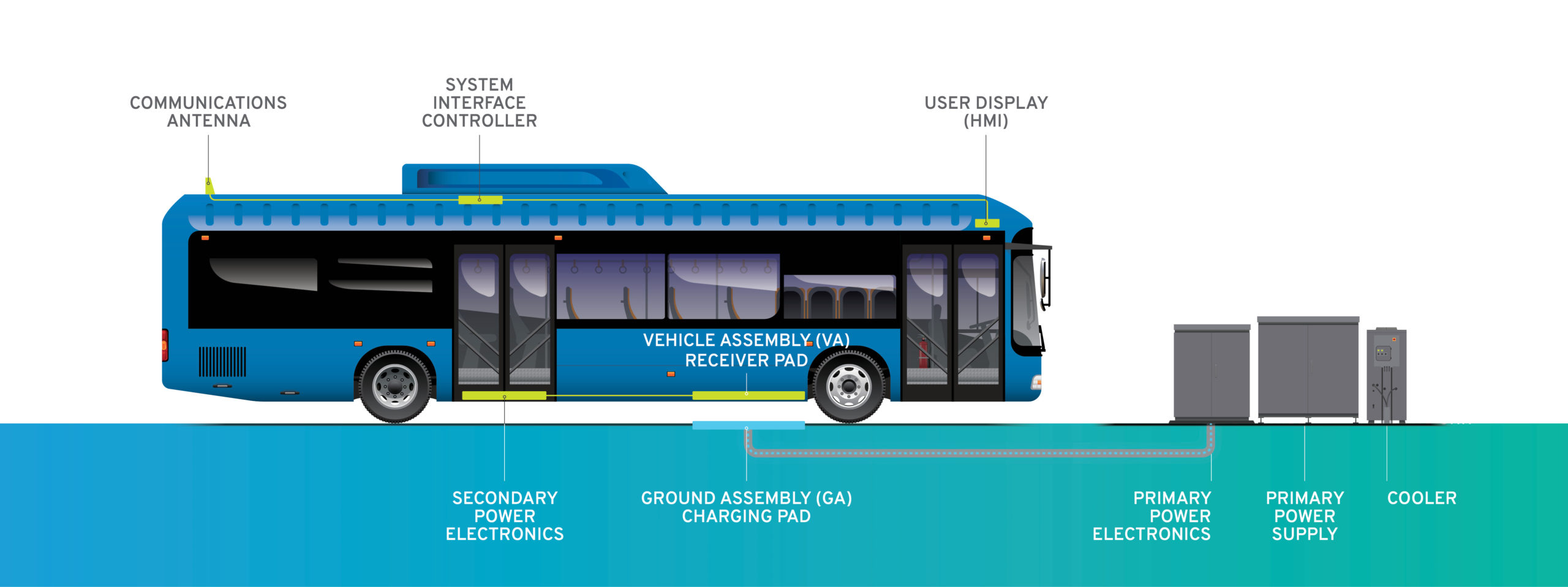
Wirelessly Powered for Maximum Range and Cost Savings
Plug-in and overhead pantograph charging systems require hands-on intervention and can be expensive to maintain. The WAVE Wireless system has no moving parts and requires no human or mechanical intervention. Within seconds of scheduled stops, the high power needed for meaningful range extension is transferred from ruggedized pads embedded in the roadway, over the air to a receiving pad on the vehicle’s undercarriage.
The WAVE Wireless systems provide up to 400 miles of range to a battery-electric bus (BEB) over 16 hours without ever being taken out of operation to charge. This enables buses to meet, and even exceed, the range of diesel buses. Projections have AVTA’s investment in WAVE wireless charging, saving the agency $1M per year compared to the cost of equipping their buses with the larger batteries and relying solely on plug-in charging in the depot.
Charging Strategies: Increasing Efficiency While Lowering Emissions and TCO
An upfront investment in Battery Electric Buses (BEBs) has well-established advantages compared to diesel:
- Environmental benefits from reduced tailpipe emissions
- Lower total cost of ownership (TCO)
Lower TCO vs. diesels results from lower operation and maintenance costs and lower costs per mile of electricity vs. diesel fuel. According to AVTA, at 8 million electric miles, the transition from diesel to BEBs has saved $2,700,000 in annual fuel costs after paying for electricity and reduced the organization’s carbon footprint by more than 47.5 million pounds of CO2 and 149,600 pounds of particulate matter.
There are two charging strategies used to support BEB operations:
- Depot-only charging often requires larger bus batteries and/or using multiple BEBs to cover long routes (known as “switch-outs”)
- On-route charging, which extends range by charging BEBs throughout the day during layovers (typically 10-20 minutes)
On-route charging (also referred to as “opportunity” or “in-route” charging) can still require overnight depot charging but charging throughout the day extends range beyond the range of onboard batteries. This allows for smaller, more affordable onboard batteries, reducing vehicle costs. Studies have also shown that topping off batteries during the day keeps from having to charge batteries from deeply depleted states, extending battery life. An additional benefit of opportunity charging is that when buses return with a higher state of charge, costly peak demand charges at the depot are reduced
Choosing the Right Charging Technology
Fleet operators such as AVTA have several factors to consider when selecting a charging technology for their BEBs. When space and labor at the depot are not constrained, lower power plug-in chargers, less than 100 kW, can work well. However, on-route charging requires higher-power chargers to maximize the available time during scheduled stops. And regardless of power, plug-in chargers are too labor-intensive, cumbersome, and time-consuming to be considered for on-route charging.

Plug-in Charging Station
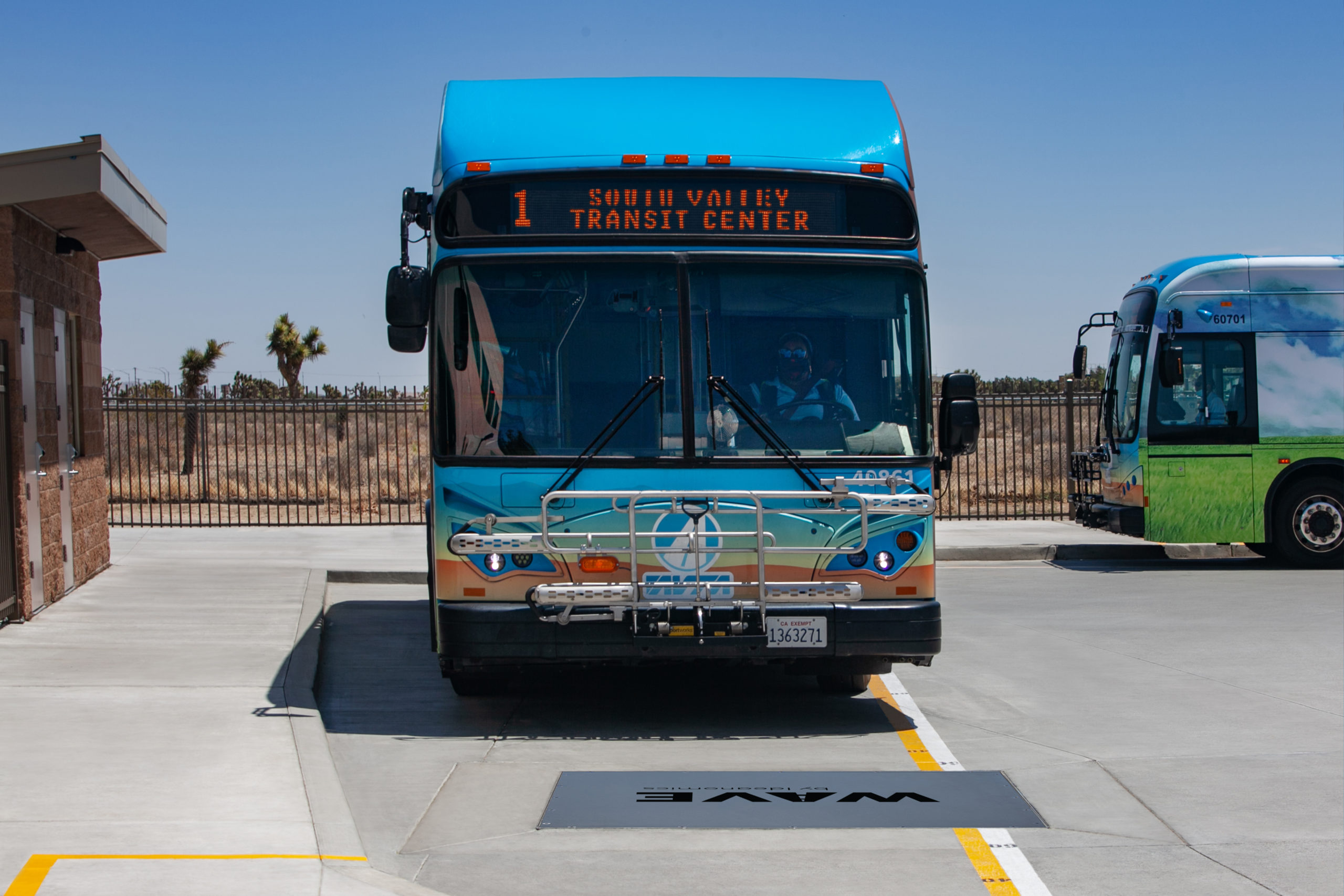
WAVE Wireless Charging Pad
Prior to the emergence of wireless charging, automated overhead pantograph systems were viewed as the only viable solution for on-route charging. These systems use a movable pantograph mounted on the roof of the vehicle or, in the case of the inverted pantograph, mounted as part of an overhead mast at the charging station.
In the case of AVTA, zoning restrictions kept the agency from deploying pantograph systems above roadways. There were safety concerns as well. Performing maintenance and repair work on pantograph systems requires a boom truck or other heavy equipment, as well as safety gear for fall protection. “Having somebody climb up on the ladder and do the work up there poses safety risks,” said Martin Tompkins, AVTA’s Executive Director and CEO. “With WAVE, the pad is on the ground, and there are no moving parts. The systems have been very reliable and very robust.”
WIRELESS (INDUCTIVE) VS. PANTOGRAPH and PLUG-IN (CONDUCTIVE)
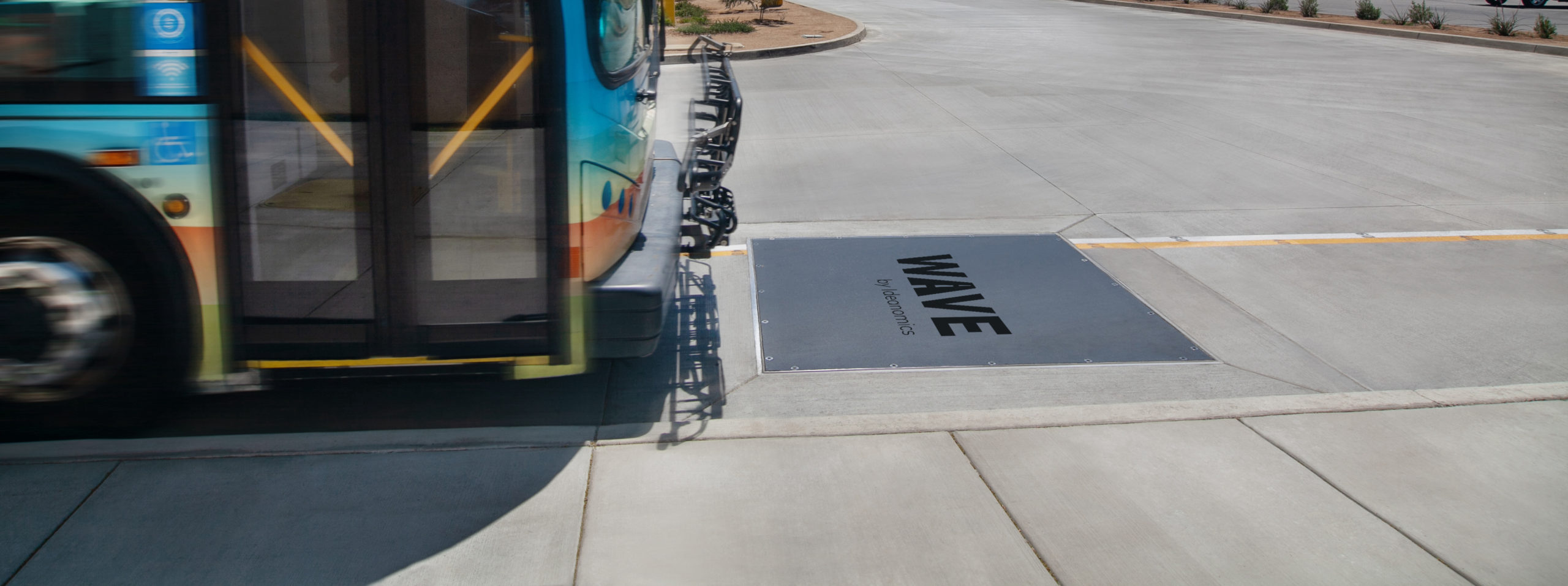
Partnering to Overcome Range Anxiety
Once AVTA decided on wireless on-route charging for their fleet, they engaged directly with their selected bus manufacturer, BYD, to arrange for the integration of the WAVE receiver plates on their 40-foot and 60-foot buses.
“I think the biggest concern for everybody is range anxiety,” said James Holtz, Regional Manager for BYD. “Providing a flexible solution like WAVE helps us overcome some objections presented by our customers.”
With the majority of AVTA routes exceeding the typical range of a BEB, every second of a scheduled stop offers AVTA an opportunity to add meaningful miles to vehicle range. Operator breaks often provide even more time to charge.
“For us, range anxiety does not exist anymore,” noted Tompkins. “The operators were trained to pull up, place the bus in neutral, set the brake, and kneel the bus. In 15 minutes, they get an additional 20 to 25 miles of range. The anxiety is gone.”
”Providing a flexible solution like WAVE helps us overcome some objections presented by our customers.
JAMES HOLTZREGIONAL MANAGER | BYD
RANGE EXTENSION
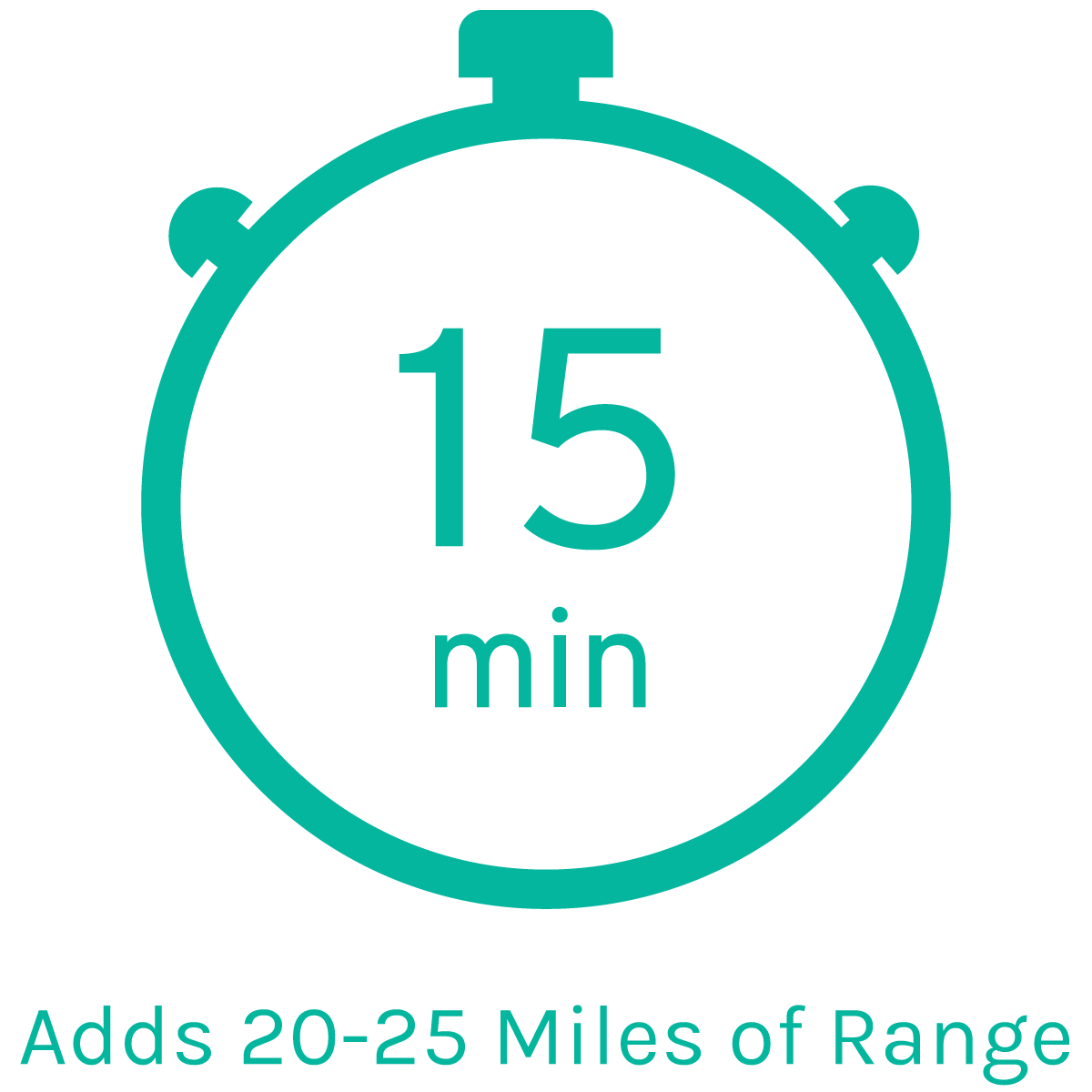
Operating with Resiliency and Flexibility
In deploying highly resilient, highly available wireless charging over 200 square miles, AVTA decentralized their charging away from the depot, better-protecting fleet operations against power outages. And whereas pantograph chargers can be challenged by extreme cold and snow, wireless offers tangible benefits. Cold weather can reduce BEB range by 20% or more. AVTA has reported that the high availability of the WAVE systems in cold weather has enabled the agency to mitigate the impact of low temperate range reduction by extending layovers by just a few minutes.
”With Wireless Charging, the pad is on the ground and there are no moving parts. The systems have been very reliable and very robust.
MARTIN TOMPKINSEXECUTIVE DIRECTOR/CEO | AVTA
A secondary benefit to a low-maintenance charging infrastructure deployed over a wide area is the ability to adapt routes to changing needs. “The WAVE systems at the transit centers afford us a lot of flexibility,” explained Tompkins. “We’ve been better able to move routes around to more easily adjust to demand.”
DECENTRALIZED LOW-MAINTENANCE CHARGING
Achieving Lower Total Cost of Ownership
With pantograph charging off the table, had wireless on-route charging not been available, battery-depleted BEBs would have to be swapped in the field with charged ones. This would have required AVTA to purchase an additional 20-37 buses.
The ability to deploy wireless charging not only saved millions on additional bus purchases but lowered labor and maintenance costs related to daily BEB switch-outs and a larger plug-in footprint in the depot.
$
SAVINGS PROJECTED OVER 12 YEARS
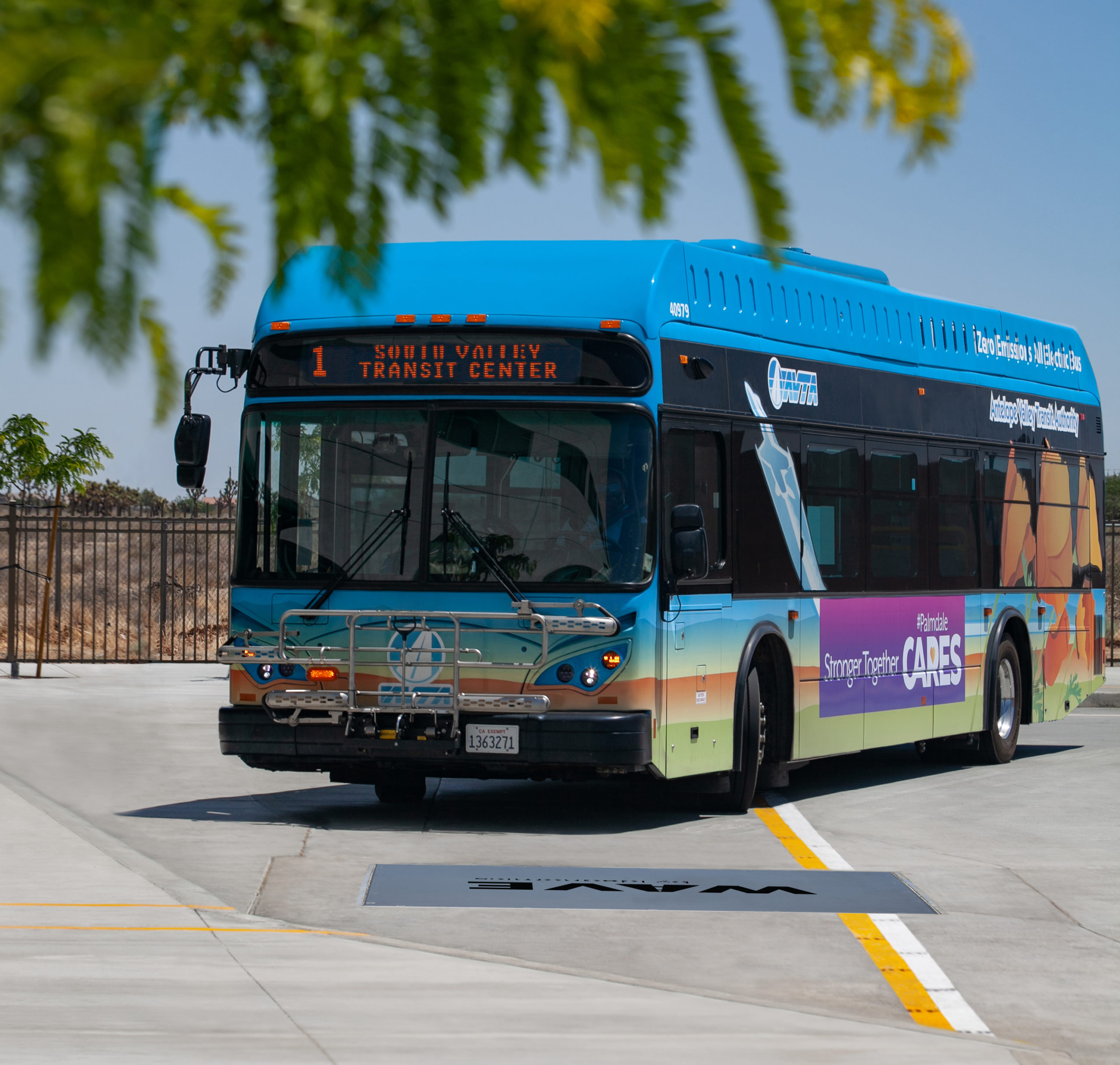
CONCLUSION
With over 2.2 million miles of range extension delivered, the success at AVTA shows that by removing the limitations of moving parts, location, and labor from charging infrastructure, battery-electric buses go farther. It’s that simple.
“WAVE has played a huge role in AVTA becoming the first all-electric zero-emission fleet.” said Martin Tompkins, AVTA’s Executive Director and CEO. “Having those chargers out there has enabled us to double vehicle range and run a lot longer.”
The Wireless solution offers interoperability among different vehicle sizes and manufacturers and comes with a standard three-year warranty.
Summary of Wireless Benefits
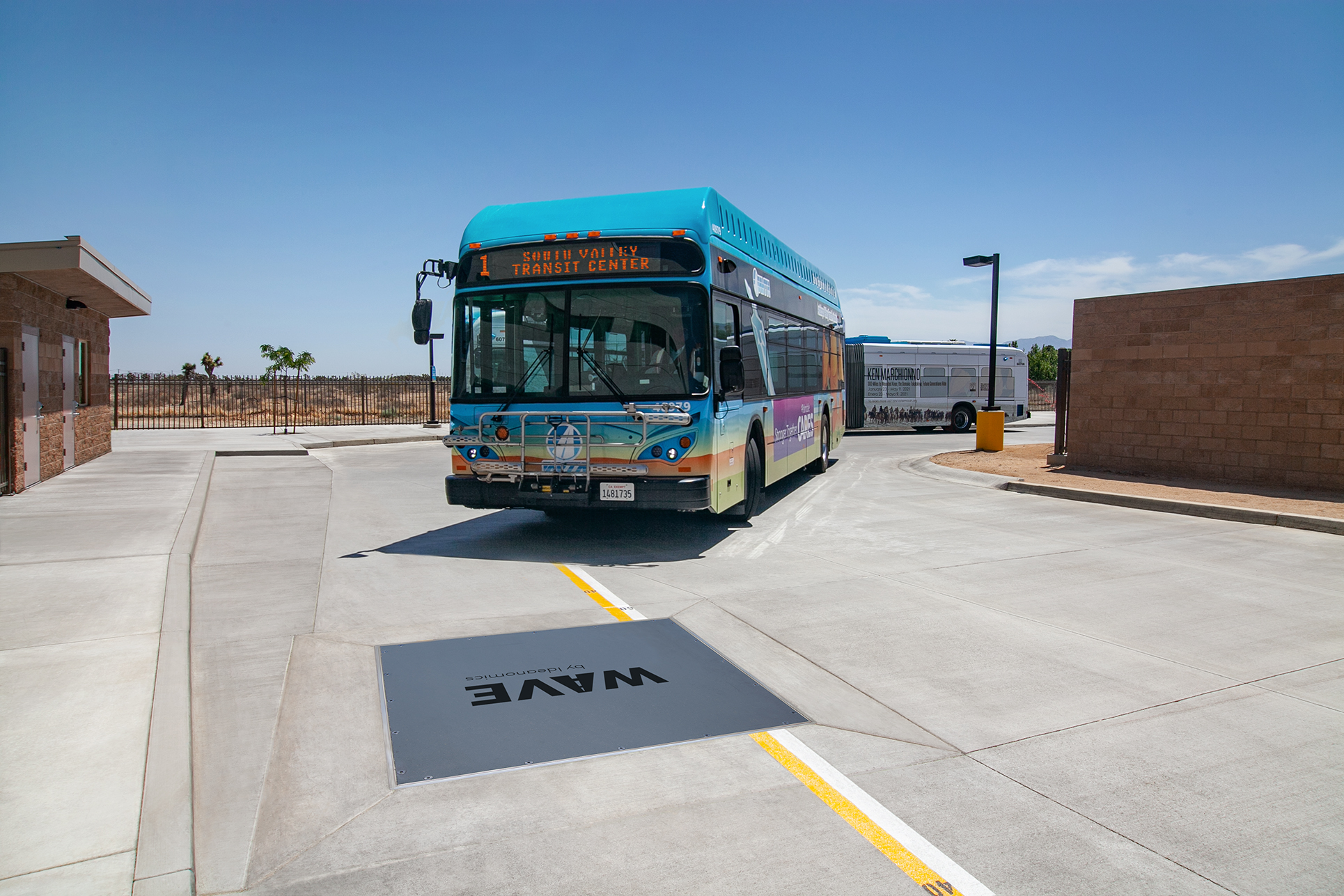
WAVE WIRELESS INTEGRATES WITH TOP BUS MANUFACTURERS
We partner with global electric vehicle manufactures to bring wireless power to battery-electric buses and medium and heavy-duty electric vehicles. Vehicles can be equipped at the time they are built or retrofitted for wireless after they are in service.
Contact Us for a Free Route Analysis
Learn more about how WAVE wireless can help your BEBs go farther and reach your zero-emission goals.
